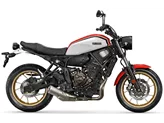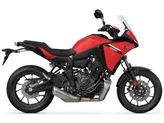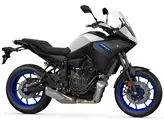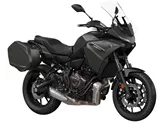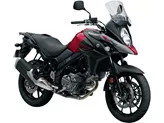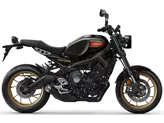Yamaha XSR700 2016 vs. Yamaha Tracer 700 2016

Yamaha XSR700 2016

Yamaha Tracer 700 2016
Overview - Yamaha XSR700 2016 vs Yamaha Tracer 700 2016
The Yamaha XSR700 and Yamaha Tracer 700, both from the 2016 model year, share many similarities in terms of their technical specifications. They both have an in-line, 2-cylinder engine with a displacement of 689cc, producing 75 horsepower and 68 Nm of torque. The fuel system is injection-based, and the transmission is chain-driven. Both bikes have a 4-stroke engine and liquid cooling.
In terms of suspension, both the XSR700 and Tracer 700 feature a telescopic fork at the front with 130mm of travel. The rear suspension consists of a swing arm with a monoshock and also offers 130mm of travel. The frame on both bikes is made of steel, providing stability and durability.
Both models come equipped with double disk brakes at the front, with a diameter of 282mm and four pistons. They also feature ABS as part of their advanced rider assistance systems, ensuring safe and reliable braking.

Yamaha XSR700 2016
When it comes to dimensions and weights, there are a few differences between the two models. The XSR700 has a front tire width of 120mm and a rear tire width of 180mm, both with a diameter of 17 inches. The wheelbase measures 1405mm, and the seat height is 815mm. With ABS, the XSR700 has a curb weight of 186kg and a fuel tank capacity of 14 liters.
On the other hand, the Tracer 700 has the same tire dimensions as the XSR700, but it has a slightly longer wheelbase of 1404mm. The seat height is higher at 835mm. With ABS, the Tracer 700 weighs 196kg and has a larger fuel tank capacity of 17 liters.

Yamaha Tracer 700 2016
In terms of strengths, the XSR700 is praised for its elastic motor, direct transmission, easy handling, and good build quality. On the other hand, the Tracer 700 is commended for its perfectly dimensioned design, offering good wind protection and ride comfort, as well as being easy to handle.
However, the XSR700 does have some weaknesses, including a chassis that is considered too soft and a seating position that may require some getting used to. On the other hand, the Tracer 700 may not be suitable for riders with relatively long legs, and its brakes are considered average.
In conclusion, both the Yamaha XSR700 and Yamaha Tracer 700 offer similar technical specifications and share many strengths. However, they do have some differences in terms of dimensions, weights, and weaknesses. Ultimately, the choice between the two will depend on the rider's preferences and intended use.
Technical Specifications Yamaha XSR700 2016 compared to Yamaha Tracer 700 2016
Pros and Cons in comparison
Pros and Cons in comparison
Yamaha XSR700 2016

If you want an entry-level motorbike that will keep you happy for a long time, but at the same time has a cool retro look, there's really no getting around the Yamaha XSR 700. With the MT-07 as the technical basis, you're buying what is probably the most popular beginner's motorbike at the moment - just in a different guise. The XSR 700's greatest triumph is its unbelievably elastic in-line two-cylinder, which neither overtaxes beginners nor bores experienced motorcyclists. The throttle response is pleasantly direct and the power develops very harmoniously, there will never be an 'oops' moment here. However, the XSR 700 should be seen as a relaxed cruiser rather than a sporty motorbike. The chassis sways very easily when ridden fast and brings uncertainty into the vehicle. Experienced riders will find it easy to cope with, but a beginner may be overwhelmed.
Yamaha Tracer 700 2016

The Yamaha Tracer 700 is clearly more mature than the other MT-07 models. It seems bigger and a little more ponderous, but also more complete and confident. It's a really good touring bike that doesn't leave you wanting for anything.
Price Comparison Avarage Market Price Yamaha XSR700 vs Yamaha Tracer 700
There are a few key differences between a Yamaha XSR700 2016 and a Yamaha Tracer 700 2016. There are the same number of bikes of both models available on the 1000PS.de marketplace, specifically 9. It takes less time to sell a Yamaha XSR700 with 85 days compared to 102 days for a Yamaha Tracer 700. Since model year 2015 1000PS.de editors have written 26 reviews for the Yamaha XSR700 and 16 reviews for the Yamaha Tracer 700 since model year 2016. The first review for the Yamaha XSR700 was published on 22/07/2015 and now has more than 13,700 views. This compares to more than 26,400 views for the first review on Yamaha Tracer 700 published on 20/04/2016.


